Legacy for Landowners
Conservation easements are a cost-effective and popular way to permanently protect crucial waterfowl habitat on private lands
Conservation easements are a cost-effective and popular way to permanently protect crucial waterfowl habitat on private lands
By T. Edward Nickens
In the famed ACE Basin of South Carolina, deep in the ducky salt marsh and rice-field estuary formed by the Ashepoo, Combahee, and Edisto Rivers, something wasn't right. A quarter-million acres of salt marsh, pine forests, and rice fields have been permanently protected in this wild swath of lowcountry, most through federal and state ownership or conservation easements on private lands. It's one of the largest intact areas of semi-wilderness left on the Atlantic Coast, and Ducks Unlimited has been active in the region for decades.
But there was a missing link: Kirkfield, an unprotected private inholding surrounded by tens of thousands of acres of protected properties. In a landscape largely dominated by massive tracts of land, Kirkfield's relatively diminutive 165 acres might have seemed easy to overlook. But the parcel had the potential to tie together a complex mosaic of public and private conservation lands, including a waterway that snaked through marsh and forest and tidal flats. Kirkfield could provide connectionas a corridor for wildlife, as a stopover for migratory birds on a continental scale, and as a piece of the framework that keeps the ACE Basin whole and unsullied.
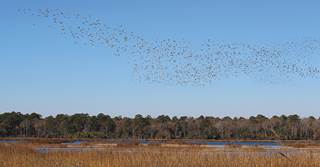
Photo Jamie Rader, DU
"We're a little postage stamp piece of property down here," laughs Todd Watkins, who bought the property with his wife, Peggy, in 2016. "We were the one little outcast that wasn't under a conservation easement, so when we bought the property, we knew that was the direction we wanted to go."
Todd and Peggy were familiar with the concept of conservation easements, in which property owners donate or sell certain rightsmost commonly development rightson land with high wildlife and ecological values. Peggy is a renowned sporting artist, and she and Todd had traveled extensively to the quail plantations of Georgia and Florida, where conservation easements not only help support astonishing populations of wild bobwhites, but undergird one of the most biologically rich landscapes in America.
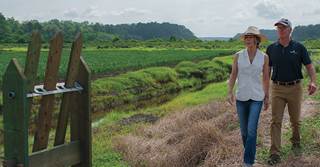
Photo Sarah Nell Blackwell
As they considered a conservation easement on Kirkfield's duck impoundments and rice fields, they had few reservations. Now, a few years after finalizing the terms of the easement with Ducks Unlimited, they have no regrets. "The increase in general wildlife on this property has just been unbelievable," Todd says. "Ducks were a focus, and we have an improved duck population. We also see wood storks, egrets, and every type of shorebird and wading bird. On some days it looks like Africa out there."
Helping to fit the larger pieces together is a useful way of thinking about DU's conservation easement programs. The voluntary legal agreements limit the uses of a parcel of land as a means of protecting and improving its conservation value. Typically, landowners sell or donate development rights while retaining rights to inhabit, farm, timber, enjoy recreational pursuits, and otherwise utilize valuable property. In return, they receive either a one-time cash payment or substantial tax savings derived from the donated value of the easement.

Conservation easements held by Wetlands America Trust, the land trust of Ducks Unlimited, protect more than 450,000 acres of crucial wildlife habitat on high-priority landscapes across the United States.
Photo Andi Cooper, DU
Most DU conservation easements are held by Wetlands America Trust (WAT), the organization's foundation and landholding arm. WAT is one of the largest accredited land trusts in the nation, holding conservation easements on more than 450,000 acres of crucial habitat across the United States. As WAT grows and expands its footprint across all flyways, easements will play an even more important role in sustaining waterfowl populations today and for the long term. "Protecting these landscapes on the front end is always more cost-effective than trying to go back and fix something that had been alive and vibrant for 10,000 years," says Randy Renner, manager of conservation programs for DU's Great Plains office.
The opportunity to make a permanent mark on the legacy of waterfowl conservation draws landowners to the concept of conservation easements. And the variety of other benefits offered by these voluntary agreements often seals the deal.
Conservation easements are not one-size-fits-all. In fact, the strength of DU's easement program is how these agreements can be tailored to varying landowner objectives.
Consider the Confluence floodplain of the Mississippi and Missouri Rivers. Here, just north of Saint Louis, Missouri, these great rivers meet in a giant matrix of lowlands, river bluffs, sloughs, flooded timber, and farmland. More than 200 established duck clubs in this area have created one of the most cherished waterfowling legacies in the country. But even that kind of history has a challenging time turning back a tide of rampant development.
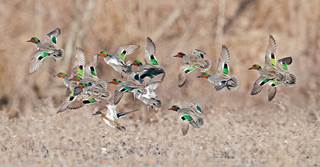
Photo davidstimac.com
Rick Holton Sr. and his family first bought 200 acres in the Confluence area in 1986, and in the years since they've amassed a 600-acre mosaic of fields, sloughs, and timber in the very heart of the Mississippi Flyway. And while taking care of migrating ducks was a primary consideration for putting their property under easement, it was hardly the only one. This storied bend in the Mississippiwhere Lewis and Clark turned west up the Missouri Riveris less than a 30-minute drive from upscale neighborhoods in the sprawling Saint Louis megalopolis.
"The city was engulfing us," Holton laments. "Over the years, we saw the lights coming." Massive new levees built after the deadly 1993 floods have attracted millions of dollars in new residential and industrial development. Nearly 30 percent of the floodplain was under threat of loss.
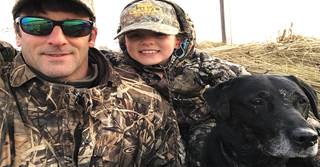
Rick Holton's son, Rick Jr., and granddaughter, Lotsie, are the future legacy of conservation on their family property in Missouri's Confluence floodplain.
Photo Rick Holton
Holton has long been a passionate voice for conservation. He has served on the board of American Rivers, and with Adolphus A. Busch IV started the Great Rivers Habitat Alliance in 2000 to help preserve open lands in the Confluence floodplain. With a 397-acre easement inked in 2013, and a second 196-acre easement signed in partnership with another co-owner in 2018, he has joined other Confluence landowners in providing a permanent bulwark against development. Year-round, these landowners collectively improve habitat by managing timber, sloughs, and fields for the overall health of the Mississippi Flyway's mighty populations of migrating waterfowl.
It hasn't come quickly, and it hasn't come without sacrifice. "Conservation takes time," Holton says. "It takes a lot of planning. And often, it takes one person passionate about conservation to get the ball rolling in a duck club or other organization. DU has been very good about identifying those people and showing them how we can work for even larger goals."
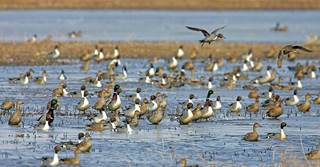
Photo garykramer.net
Nicole Montna Van Vleck can attest to that. In many instances, landscapes that are crucial for wildlife are also landscapes that are vital for agriculture and other enterprises. Van Vleck, of California's Sacramento Valley, understands that balancing a strong conservation ethic with a solid business plan that allows for future growth is hardly straightforward. "Easements are in perpetuity," she says, "so you have to think about every item that could become an issue 100 or 200 years from now."
Van Vleck is president and CEO of Montna Farms, a major rice producer in a vital Pacific Flyway wintering area where agriculture provides much of the nutritional needs of waterfowl. Over the last 19 years, working closely with the Montna family, DU has secured easements on four Montna Farms properties, totaling nearly 2,000 acres.
It's a heritage of conservation that reaches back for decades. In the late 1990s, rice farmers typically burned rice straw in the fields after harvest, sending large plumes of smoke boiling into the air. Van Vleck's father, Al Montna, was an early adopter in the shift to using water instead of fire to break down rice strawflooding fields instead of burning them. A side benefit was a massive influx of ducks, geese, and shorebirds. An advisory senior vice president on DU's board of directors, and an instrumental force in founding DU's Rice Stewardship Partnership with USA Rice, Montna signed the first easement on family properties in 2002 and has been an ambassador for DU's easement program ever since. Now his daughter is taking on the mantle not only as business leader, but as the shepherd of the family's deep conservation ethic.
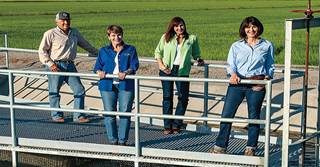
(From left) Al Montna, Gail Montna, Michelle Montna Vogt, and Nicole Montna Van Vleck grow rice in California's Sacramento Valley. The family helped pioneer the use of working lands easements that are a win-win for rice farmers and wildlife.
Photo DL Cunningham Photography
What makes a conservation easement work, she says, is the relationship between the landowner and the easement holder. "You are, in some ways, taking on a partner, and that requires working out the details of what the relationship will be. But our trust in DU brought us a lot of comfort. We've worked long and hard to get the language right."
And the result is a long tenure of getting the conservation right. That very first easement restricted development rights but allowed continued agricultural use of the land, Van Vleck says. It also included an agreement to provide water each winter for wintering waterfowl, which was a new concept for the area.
But also important was the message to the community that conservation easements can help ensure the long-term viability of family farms. "We're in the rice business," Van Vleck says, "and it was important for us to make a statement that we will be in the rice business for the long term. This conservation easement was as much a commitment to our family farming heritage as it was about ducks. Done right, an easement can protect legacy. And it's a win for agriculture and a win for the environment."
Such testimony can allay the fears some landowners might initially have about conservation easements. In fact, the voluntary nature of these agreements, and the collaborative spirit behind them, can make conservation easements work even under challenging situations.
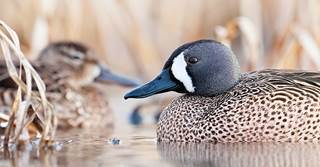
Photo davidstimac.com
Consider the Dakotas. While the majority of easements held by WAT are sold or donated by landowners, there are places where that is difficult to accomplish. Nonprofit organizations aren't allowed to hold perpetual conservation easements in North Dakota, Renner says, and land ownership by conservation organizations is strictly regulated. To work for conservation there, in the so-called Duck Factory, DU has formed a long-term partnership with the US Fish and Wildlife Service (USFWS), through which DU helps fund and facilitate the purchase of easements protecting high-quality wetlands and grasslands while the federal agency holds the easements themselves.
It's an arrangement that suits Bruce Haerter well. A third-generation rancher and banker and an avid hunter, Haerter works a ranch in north-central South Dakota, where high-quality prairie pothole habitat can support an incredible 100 pairs of nesting ducks per square mile. But it is also a region with a strong agricultural heritage where working landscapes are treasured.

Photo michaelfurtman.com
Haerter recently signed grassland and wetland easements on nearly 1,500 acres, including large swaths of native prairie that have never seen a plow and land on which he'll implement a rotational grazing system for his cattle. The wetland easements on the Haerter ranch will protect more than 180 acres of temporary, seasonal, and semipermanent wetlandsjust the kind of habitat that pulls in both nesting and migrating ducks and geese.
What makes the easements work, Haerter says, is the ability to continue ranching within certain guidelines. In his area, for example, landowners with easements on their grasslands are still allowed to harvest hay but agree not to cut it until after July 15, when most bird nesting is complete. "And natural grazing can occur in a way that ensures there is enough grass on the landscape to provide cover for ducks, pheasants, partridges, and grouse," Haerter explains. "It's expensive to buy all your feed for a cattle operation, so the conservation aspects of the easements actually help ensure ranch continuity."
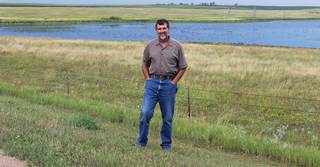
Third-generation cattle rancher Bruce Haerter partnered with US Fish and Wildlife Service and DU to conserve wetlands and native prairie on grazing lands in north-central South Dakota.
Photo Randy Meidinger, DU
It's a good example of how versatile conservation easements can be. "The people I've worked with are very knowledgeable about grasslands and wetlands but also about farming and ranching and the realities we face out here," Haerter says. "It all comes down to relationships and communicating needs. DU understands that these acres need to support livestock and ranching and farming communities, and they understand that conservation isn't free. Without economic vitality and well-being in these rural areas, there would be no conservation, either."
It's that kind of holistic approach that makes conservation easements work for such a variety of landowners. Whether landowners seek to preserve the wild character of their lands, continue a legacy of family farming, or ensure the vitality of critical habitats for migrating birds, the easement programs administered by DU and WAT are customizable tools that pay benefits both now and far into the future. Sometimes without seeming to change a thing.
"It's interesting," says Chad Carlson, a realty specialist with the USFWS in South Dakota who has worked with DU on many conservation easements. "If you were to drive by a prairie ranch with lands under conservation easement, it might not look all that different from surrounding lands. But the beautiful thing about an easement is you'll be able drive by the land in 10 years, or 50 years, or 100 years, and it's still going to be protected. It's still going to be making ducks."
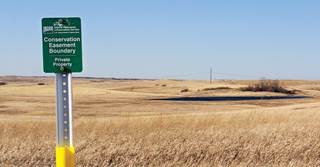
Photo michaelfurtman.com
Ducks Unlimited uses cookies to enhance your browsing experience, optimize site functionality, analyze traffic, and deliver personalized advertising through third parties. By continuing to use this site, you agree to our use of cookies. View Privacy Policy